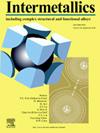纳米压痕法表征镍基单晶高温合金残余应力及其对力学性能的影响
IF 4.8
2区 材料科学
Q2 CHEMISTRY, PHYSICAL
引用次数: 0
摘要
采用不同压头测量残余压应力的大小,表征残余压应力对镍基单晶高温合金力学响应的影响。基于圆柱扁冲压头得到的降模量,计算了锥体压头在加载段的压痕硬度和实际投影接触面积,避免了压痕下沉或堆积的影响。此外,根据Nix-Gao模型和实际投影接触面积,可以重建锥体压头在加载段的压痕载荷深度曲线,该曲线不受压痕尺寸效应的影响。基于修正后的压痕载荷-深度曲线,根据锥体压痕载荷功的差异计算残余压应力的大小,并通过David模型的计算结果进行验证。研究发现,残余压应力对弹性模量和折减模量的影响不大;压痕硬度、接触刚度-深度曲线斜率和接触面积均随残余压应力的增大而增大;残余压应力增强了NBSX抗蠕变和塑性变形的能力。本文章由计算机程序翻译,如有差异,请以英文原文为准。
Characterization of residual stress and its effect on mechanical properties of nickel–based single crystal superalloys by nanoindentation
Different indenters are used to measure the magnitude of residual compressive stress and characterize the influence of compressive residual stress on the mechanical response of nickel–based single crystal superalloy. Based on the reduced modulus obtained by a cylindrical flat punch indenter, the indentation hardness and actual projected contact area of the pyramidal indenter at loading segment are calculated, which avoid the effect of indentation sinking–in or piling–up. Furthermore, according to the Nix–Gao model and actual projected contact area, the indentation load–depth curves of the pyramidal indenter at loading segment can be reconstructed, which are not affected by the indentation size effect. Based on the corrected indentation load–depth curves, the magnitude of residual compressive stress is calculated according to the difference in the loading work of the pyramidal indenter, and verified by the calculation results of David's model. It is found that the elastic modulus and reduced modulus are not affected by the residual compressive stress; the indentation hardness, slope of the contact stiffness – depth curve and contact area show an increasing regime as residual compressive stress increases; residual compressive stress enhances the ability of NBSX to resist creep and plastic deformation.
求助全文
通过发布文献求助,成功后即可免费获取论文全文。
去求助
来源期刊

Intermetallics
工程技术-材料科学:综合
CiteScore
7.80
自引率
9.10%
发文量
291
审稿时长
37 days
期刊介绍:
This journal is a platform for publishing innovative research and overviews for advancing our understanding of the structure, property, and functionality of complex metallic alloys, including intermetallics, metallic glasses, and high entropy alloys.
The journal reports the science and engineering of metallic materials in the following aspects:
Theories and experiments which address the relationship between property and structure in all length scales.
Physical modeling and numerical simulations which provide a comprehensive understanding of experimental observations.
Stimulated methodologies to characterize the structure and chemistry of materials that correlate the properties.
Technological applications resulting from the understanding of property-structure relationship in materials.
Novel and cutting-edge results warranting rapid communication.
The journal also publishes special issues on selected topics and overviews by invitation only.
 求助内容:
求助内容: 应助结果提醒方式:
应助结果提醒方式:


